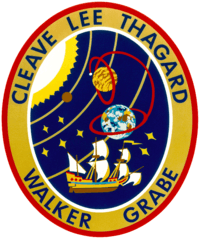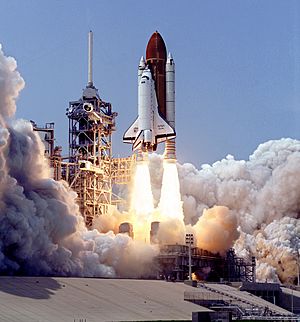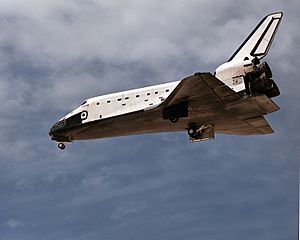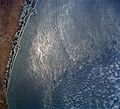STS-30 facts for kids

Magellan and its IUS in the payload bay of Atlantis
|
|
| Names | Space Transportation System-29 STS-30R |
|---|---|
| Mission type | Magellan spacecraft deployment |
| Operator | NASA |
| Mission duration | 4 days, 0 hours, 56 minutes, 27 seconds (achieved) |
| Distance travelled | 2,377,800 km (1,477,500 mi) |
| Orbits completed | 65 |
| Spacecraft properties | |
| Spacecraft | Space Shuttle Atlantis |
| Launch mass | 118,441 kg (261,118 lb) |
| Landing mass | 87,296 kg (192,455 lb) |
| Payload mass | 20,833 kg (45,929 lb) |
| Crew | |
| Crew size | 5 |
| Members |
|
| Start of mission | |
| Launch date | 4 May 1989, 18:46:59 UTC |
| Rocket | Space Shuttle Atlantis |
| Launch site | Kennedy Space Center, LC-39B |
| Contractor | Rockwell International |
| End of mission | |
| Landing date | 8 May 1989, 19:43:26 UTC |
| Landing site | Edwards Air Force Base, Runway 22 |
| Orbital parameters | |
| Reference system | Geocentric orbit |
| Regime | Low Earth orbit |
| Perigee | 361 km (224 mi) |
| Apogee | 366 km (227 mi) |
| Inclination | 28.45° |
| Period | 91.80 minutes |
 STS-30 mission patch  Ronald J. Grabe, David M. Walker, Norman E. Thagard, Mary L. Cleave, Mark C. Lee |
|
STS-30 was the 29th NASA Space Shuttle mission. It was the fourth flight for the Space Shuttle Atlantis. This mission was also the fourth shuttle launch since the Challenger accident. It was the first shuttle mission after that event to include a female astronaut.
The mission launched from Kennedy Space Center, Florida, on May 4, 1989. It landed four days later on May 8, 1989. During the flight, Atlantis successfully launched the Magellan probe. This probe was on its way to explore the planet Venus.
Contents
Meet the Astronauts: STS-30 Crew
| Position | Astronaut | |
|---|---|---|
| Commander | David M. Walker Second spaceflight |
|
| Pilot | Ronald J. Grabe Second spaceflight |
|
| Mission Specialist 1 | Mark C. Lee First spaceflight |
|
| Mission Specialist 2 | Norman E. Thagard Third spaceflight |
|
| Mission Specialist 3 | Mary L. Cleave Second and last spaceflight |
|
Getting Ready: Shuttle Processing
After its previous flight, Atlantis spent three months at the Orbiter Processing Facility (OPF-2). This is a special hangar at the Kennedy Space Center. During this time, technicians worked hard to repair the shuttle. They replaced damaged heat shield tiles that Atlantis got from its last trip. They also checked the shuttle very carefully.
On March 11, 1989, Atlantis was moved to the Vehicle Assembly Building. There, it was connected to its large external fuel tank and two solid rocket boosters. Eleven days later, on March 22, 1989, Atlantis was rolled out to Launch Pad 39B, ready for its next mission.
Mission Highlights: What Happened in Space
Space Shuttle Atlantis launched from Launch Complex 39B in Florida. The launch happened at 2:46:59 PM EDT on May 4, 1989. The main goal of the mission was to deploy the Magellan spacecraft. This spacecraft, along with its attached Inertial Upper Stage (IUS), was successfully released later that day. Magellan was the first American mission to another planet in 11 years.
The launch was first planned for April 28, 1989. This date was chosen because Earth and Venus were lined up correctly. However, the launch was stopped just 31 seconds before liftoff. There was a problem with a pump on one of the main engines. There was also a small leak in a fuel line.
On the new launch date, May 4, 1989, the launch was delayed again. This time, it was due to clouds and strong winds at the launch site. Good weather conditions were needed in case the shuttle had to make an emergency landing right after liftoff.
Small Challenges During the Flight
The crew faced a few minor issues during the mission. On May 7, one of the shuttle's four main computers stopped working. The astronauts successfully replaced it with a backup computer. This was the first time a computer had been replaced in space. This problem did not affect the crew's safety or the main goals of the mission. However, some experiments had to be paused while the computer was being fixed.
Another small issue was with one of the thrusters on Atlantis' right side. It failed during the ascent into orbit. This also did not impact the mission.
Other small problems included a Hasselblad camera. Its shutter got stuck, so it couldn't be used for the rest of the flight. A system for sending images and graphics from Mission Control also jammed. The water dispenser in the galley, where the crew prepared meals, also had a problem. Despite these small annoyances, the crew completed their main tasks.
Atlantis landed at Edwards Air Force Base in California. It touched down on Runway 22 at 3:43:27 PM EDT on May 8, 1989. The runway had to be changed at the last minute because of strong crosswinds. The entire mission lasted 4 days, 0 hours, 56 minutes, and 28 seconds.
Science in Space: Payloads and Experiments
The Magellan spacecraft was released from the shuttle's cargo bay about six hours after launch. Two powerful rocket burns from the IUS then sent Magellan on its way to Venus. Magellan reached Venus in August 1990. It then began a 243-day mission to map the planet's surface using radar.
The mission also included three experiments inside the crew cabin. All of these had been flown before. Astronaut Mary Cleave used a laptop computer to control the Fluids Experiment Apparatus (FEA). This experiment studied how liquids behave in space. For the first time on the Shuttle, an 8 mm (0.31 in) video camera was used. This allowed the crew to record their activities and send the videos back to Earth. Cameras in the cargo bay also recorded storm systems from orbit. This was part of the Mesoscale Lightning Experiment, which studied lightning from space.
Wake-up Calls: Music from Space
NASA started a fun tradition of playing music to astronauts during the Project Gemini missions. They first used music to wake up the crew during Apollo 15. Each song is chosen carefully, often by the astronauts' families. The songs usually have a special meaning to an astronaut or relate to their daily tasks.
| Flight Day | Song | Artist/Composer |
|---|---|---|
| Day 2 | Theme from the film "Superman" | |
| Day 3 | Anchors Aweigh The Wild Blue Yonder Colorado State University Fight Song Florida State University Fight Song |
|
| Day 4 | "Gonna Fly Now" - Theme from Rocky | Bill Conti |
| Day 5 | "A Hard Day's Night" | The Beatles |
Images for kids
-
Ocean waves off the coast of Mexico imaged from orbit.
See also
 In Spanish: STS-30 para niños
In Spanish: STS-30 para niños









